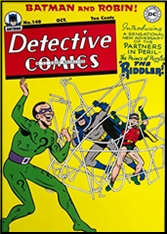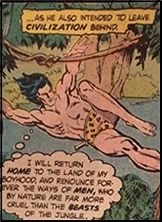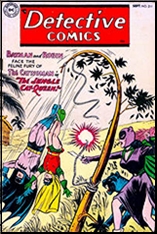Fri 20 Oct 2023
Comic Book Stories I’m Reading: BATMAN AND ROBIN “The Riddler.”
Posted by Steve under Comic Books I'm Reading[9] Comments
BATMAN AND ROBIN “The Riddler.” First published in Detective Comics #140, October 1948. Facsimile edition: DC Comics, December 2023. Writer: Bill Finger. Penciler: Dick Sprang.

I don’t know how many facsimile editions such as this that DC Comics has published — and if anyone can tell me where/how to find out, I’d really like to know — but let me tell you right now and up front, I think it’s a great idea, and I hope they’re making a lot of money at it.
As far as I can tell, there are only a couple of tiny places in the reprint edition of Detective Comics #140 differs from the original. One’s the price, as indicated on the front cover. In 1948, it was Ten Cents. Here and now in 2023, it’s $4.99. Taking inflation into account, I think today’s price is an out-and-out bargain.
The other difference is the indicia — the small fine print at the bottom of the first page that describes the publishing info for the comic, all nicely updated for the newer version. The paper and coloring seem nicer too, but the only way to be certain about that is to go back to 1948 and buy a copy fresh off the newsstand. You’d need a time travel machine to start with, though, and then a slim Mercury (?) dime. (I’ll furnish the dime.)

The reason for reprinting this particular issue didn’t make any big impression at the time, I’m sure, but it was the very first appearance of one of Batman’s favorite longstanding villains — well, a favorite of Batman’s fans, but perhaps not Batman himself — the Riddler. The latter’s real name was Edward Nigma (I’ll let you work that one out for yourself), and as this story relates it, the soon-to-be villain grew up as a schoolboy who loved puzzles of all kinds — well, so did I, but young Nigma cheated at doing them.
When older, he became one of those guys who constantly challenged Batman to decipher a riddle or rebus which when unclued would tell the latter where and when the former’s next robbery or holdup would take place.
All of the Riddler’s storylines were clever and a lot of fun to read. The artwork is still cartoony — but not overpoweringly so. I would like to think that both scriptwriter Bill Finger and artist Dick Sprang are in a comic book Hall of Fame. If not, they should be.
Other stories in this issue:
Robotman: “Robotman’s Double Trouble”
Slam Bradley: “Dog for a Day”
Boy Commandos: “The Dictator from Alcatraz”









